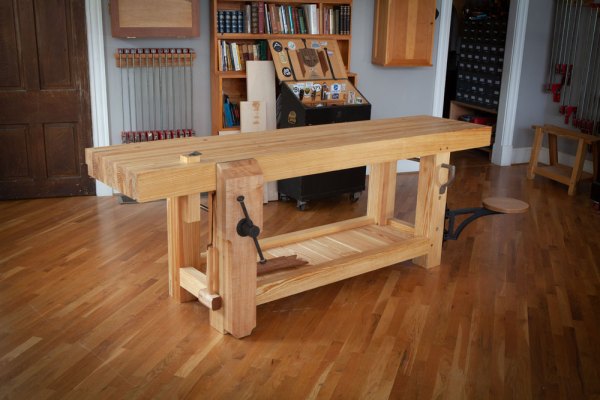
At first glance, the workbench in “The Anarchist’s Workbench” appears to be almost identical to the bench I built in 2005, which has shown up in a number of magazines and books. It’s chunky, made from yellow pine and the workholding is a leg vise, planing stop and holdfasts.
Despite their similarities, the workbench plan in this book is a significant improvement. During the last 15 years I have found better ways to laminate the top using fewer clamps, easier ways to make the massive joints, plus layout tricks here and there that result in tighter joints all around. The top is thicker, heavier and creates less waste when using 2×12 dimensional lumber.
The workholding is far more effective. Thanks to improvements in vise manufacturing and a mature understanding of how these leg vises work, the vise is strong enough to hold boards without the help of a sliding deadman. There is no parallel guide, so you can work at the vise without stooping. The planing stop uses a metal tooth, made by a blacksmith, that holds your work with a lot less sliding. And the pattern of holdfast holes in the top – something that took me years to get right – ensures there will almost always be a hole right where you need one.
The fact that the bench is similar to my bench from 2005 is somewhat of a comfort to me. It means I wasn’t too far off the mark when I began my journey. And equally remarkable is that 15 years of building workbenches of all different forms, from Roman benches to a miniature one from Denmark, wasn’t able to shake my conviction that a simple timber-framed bench is ideal for many woodworkers.
In addition to the fully matured workbench design, this book also dives a little deeper into the past to explore the origins of this form. I first encountered this type of bench in a French book from about 1774, and at the time I couldn’t find much else written about it. Since then, libraries and museums have digitized their collections and opened them to the public. So we’ve been able to trace its origins back another 200 years and found evidence it emerged somewhere in the Low Countries or northern France in the 1500s. We also have little doubt there are more discoveries to be made.
And finally, the story of this bench is deeply intertwined with my own story as a woodworker, researcher, publisher and – of course – aesthetic anarchist.
That’s why we’ve decided to give away the content of this book to the world at large. When it is released later this summer, the electronic version of the book will be free to download, reproduce and give away to friends. You can excerpt chapters for your woodworking club. Print it all out, bind it and give it away as a gift. The only thing you cannot do is sell it or make money off of it in any way.
If you prefer a nicely bound book instead of an electronic copy, we sympathize. That’s what we prefer, too. So we plan to print some copies of this book for people who prefer it in that format. Those will cost money to manufacture (we don’t make low-quality crap here at Lost Art Press) so we won’t be able to give those away. But we will sell them – as always – at a fair price for a book that is printed in the United States, sewn, bound in fiber tape and covered in a durable hardback.
This book is the final chapter in the “anarchist” series – “The Anarchist’s Tool Chest,” “The Anarchist’s Design Book” and now “The Anarchist’s Workbench.” And it is (I hope) my last book on workbenches. So it seemed fitting that to thank all the woodworkers who have supported me during this journey, this book should belong to everyone.
— Christopher Schwarz
P.S. If this goes well, John and I are discussing making the other two books in the anarchist series free to download. We don’t know when (or exactly how) we will make that decision. But it is on the table.